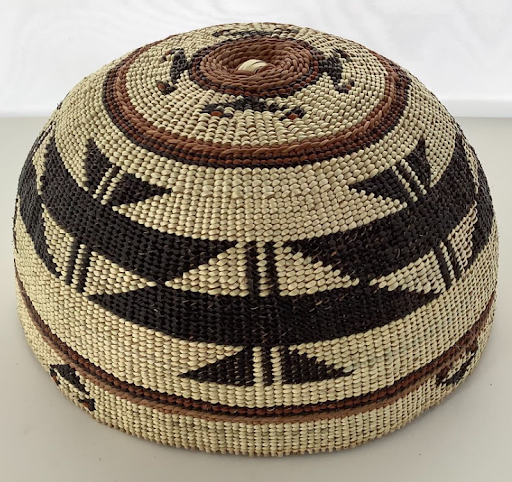Overview
Basketry Designs and Area

Authors and Collaborators:
- Andrea Butler-Crosby, Educator
- Lisa Morehead-Hillman (Yurok/Karuk/Shasta), Master Basket Weaver and Educator
- Lesson Contributor/Editor/Format by Maggie Peters (Yurok/Karuk), NASMC Learning Specialists Humboldt County Office of Education
Grades: 3 and 4
Suggested Amount of Time: Three 60-80 minute sessions
Curriculum Themes:
- Cultural Strengths
- Cross Curricular Integration
Learning Goals
- Understand the geometry of basket designs used by Karuk basketweavers
- Investigate the importance of math as used by basketweavers
- Explore the area of traditional, culturally relevant basketry design shapes by covering the geoboard or worksheet spaces with square and partial square units
Lesson Overview
This lesson invites students into a unique and meaningful exploration of Native California basketry through the lens of mathematics and cultural knowledge. Grounded in the traditions of the Karuk, Yurok, and Hupa peoples of Northwestern California, students will examine traditional basket designs and discover the geometry and symbolism woven into each pattern.
Students begin by learning about the importance of baskets in Native communities—not only as tools used for cooking, gathering, and ceremony, but as expressions of identity, knowledge, and connection to the land. They will hear directly from a traditional basket weaver through video and explore visual examples of real baskets, noticing the patterns, stories, and craftsmanship each one holds.
The lesson then shifts into hands-on mathematical discovery. Students work with patterns found in basketry to explore the concept of area, building shapes using grid paper or geoboards. By calculating how much space these shapes take up, they’re able to apply their math knowledge in a culturally relevant and visually engaging context. This activity encourages students to think like designers and problem-solvers—just like traditional weavers do.
Working in pairs or small groups, students take on the role of young mathematicians and artists as they collaborate to analyze basket patterns and calculate area. Teachers are encouraged to support student dialogue through rich questions that prompt reasoning, exploration, and multiple strategies.
To deepen their understanding, students reflect on the materials used in basket making and consider the knowledge systems behind the designs. They learn how traditional weaving is connected to land care, seasonal cycles, and community values—demonstrating how Indigenous knowledge systems incorporate science, mathematics, and sustainability.
The lesson concludes with individual reflection, where students demonstrate their understanding of area and share their insights about the cultural significance of the designs they've studied.
This is more than a math lesson—it's an opportunity to honor Native perspectives, make learning relevant and engaging, and show students how math exists in the world around them in powerful and beautiful ways.
Whether you’re hoping to integrate cultural studies into your math block or looking to deepen students’ understanding of geometry through real-world applications, Basketry Designs and Area provides an interdisciplinary, respectful, and enriching learning experience that students will remember.
Teacher Background
When teaching about Indigenous peoples and their traditions, it’s essential to approach the lesson with care, respect, and a commitment to authenticity. Indigenous cultures are not just part of history—they are living, evolving, and thriving today. Lessons that center Native knowledge, such as basket weaving and land stewardship, should honor the people who carry these traditions and acknowledge the depth and significance of what is being shared.
The Karuk, Yurok, and Hupa peoples are Indigenous to the rivers, mountains, and forests of northwestern California. Their territories span what is now known as Siskiyou, Humboldt, and Trinity Counties, and their connections to these lands go back to the beginning of time, long before state or county borders existed. These lands are not just where they lived—they are integral to their identities, stories, and ways of knowing the world.
For these communities, basket weaving is a practice that goes far beyond art or utility. It reflects generations of knowledge, cultural values, and skilled mathematics. Baskets are used in every aspect of life: for cooking, gathering, ceremonial dress, and as cradles for babies. They carry stories and meaning, and their patterns are created through careful calculations and thoughtful design. Students learning about these traditions have the opportunity to engage with geometry in a meaningful, culturally rooted way.
The materials used for weaving—such as hazel sticks, willow, bear grass, and ferns—require special care and are collected during specific seasons. To ensure strong and healthy basketry plants, Karuk, Yurok, and Hupa people have used low-intensity fire as a land management tool for thousands of years. These cultural burns help encourage growth, maintain biodiversity, and reduce the risk of destructive wildfires. This kind of ecological knowledge is both spiritual and scientific, reflecting the long-standing relationship between people and place.
When introducing students to this lesson, it is important to present the cultures of the Karuk, Yurok, and Hupa peoples as living and contemporary. Use present-tense language and avoid teaching from a historical-only perspective. Share stories or videos from current tribal members and artists when possible. Native voices should be central in any lesson about Indigenous knowledge and tradition. Remind students that each tribe has its own unique culture, and avoid making broad generalizations. Teaching about Karuk, Yurok, and Hupa communities should reflect their distinct identities and practices.
In the classroom, highlight the strength, creativity, and contributions of Native communities. Rather than focus solely on hardship or loss, celebrate resilience, innovation, and leadership. Connect their cultural practices to core academic content areas like math, science, and art to help students see Indigenous knowledge as rigorous and relevant. Lessons like this one offer a chance for students to see that math exists beyond textbooks—it lives in tradition, design, and the natural world.
By engaging with basketry through a lens of respect and cultural appreciation, educators help students understand that Indigenous traditions are not just worthy of study—they are vital sources of knowledge, expression, and identity that continue to shape our world today.

